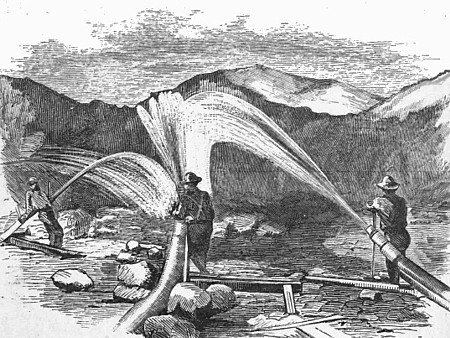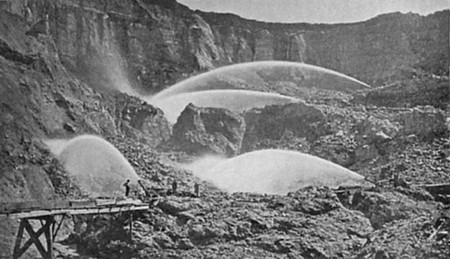Hydraulic mining is the cheapest known method of recovering gold. In four years the North Bloomfield Mining Company of California worked 325,000,000 cubic yards, which yielded only 2.9 cents of gold per cubic yard, and realized some profit. Very poor gravel will pay when the conditions are good. Cheap water, grades of four inches in a hundred, ample dumping room, big banks of light gravel, large areas of deposits, can make low grades economic using larger scale methods. This was done by hydraulic mining, where great jets of water under heavy head pressures were directed against banks of gravel hundreds of feet in height. The gravel banks were thus disintegrated and the material washed over sluices. Some of the jets of water were 9 inches in diameter as they left the nozzles. After the proper ditches and pipe lines had been installed, thousands of cubic yards of gravel could be washed without hand labor. The gold was recovered in riffle-sluices, and quicksilver was usually added to aid in its recovery, using amalgamation. Another method of working these deeper deposits, particularly where they do not contain water, is by the hydraulic elevator, an upright pipe into the bottom of which the gravel is drawn by a jet of water under head that also raises it to the top (sometimes 40 ft.), where it is sluiced in the usual manner. It is not, however, proposed in this article to enter into a discussion of the relative conditions surrounding the most advantageous use of each of the methods mentioned. Water was drawn from the reservoirs and often conducted for miles in order to bring it to the desired point and to obtain sufficient head or pressure for the work in hand. As the mining operations and supplies of water lay at the two extremes in point of altitude, considerable engineering skill was required to surmount the intervening obstacles of a rugged topography.
Hydraulic Mining. After the board-sluice, with its various adjuncts of riffle-bars, stone bottoms, copper plates, and so forth, the next instrument of importance for gold mining during the California gold rush, is the hydraulic hose, used to let water down from a considerable height, and throw it under the pressure of its own weight against the pay-dirt, which is thus torn down, broken up, dissolved and carried into the sluice below. The sluice is a necessary part of hydraulic mining. The hose is used, not to wash the dirt, but to save digging with shovels, and to carry it to the sluice. The hydraulic process is applied only in claims where the dirt is deep and where the water is abundant. If the dirt were shallow in the claim and its vicinity, the necessary head of water could not be obtained. Hydraulic claims are usually in hills. The water is led along on the hill at a height varying from fifty to two hundred feet above the bed-rock, to the claim at the end or side of the hill, where the water, playing against the dirt, soon cuts a large hole, with perpendicular or at least steep banks. At the top of the bank is a little reservoir, containing perhaps not more than a hundred gallons, into which the water runs constantly, and from which the hose extends down to the bottom of the claim. The hose is of heavy duck, sometimes double, sewn by machine.
This hose when full is from four to ten inches in diameter, and will bear a perpendicular column of water fifty feet high ; but a greater height will burst it. Now, as the force of the stream increases with the height of the water, it is a matter of great importance to have the hose as strong as possible ; and for this purpose, in some claims, it is surrounded by iron bands, which are about two inches wide, and ;ire connected by four ropes which run perpendicularly down. The rings are about three inches apart. The " crinoline hose," thus made, is very flexible, and will support a column of water one hundred and fifty or two hundred feet high. The pipe at the end df the hose is like the pipe of a fire-engine hose, though usually larger. Sometimes the pipe will be eight inches in diameter where its connects with the hose, and not more than two inches at the mouth ; and the force with which the stream rushes from it is so great, that it will kill a man instantaneously, and tear down a hill more rapidly than could a hundred men with shovels. One or two men are required to hold the pipe. They usually turn the stream upon the bank near its bottom until a large mass of dirt tumbles down, and then they wash this all away into the sluice; when they commence at the bottom of the bank again, and so on. If the bank is one hundred and fifty feet high, the mass of earth that tumbles down is of course immense, and the pipe men must stand far off, for fear that they will be caught in the avalanche. Such accidents are of daily occurrence, and the deaths from this cause probably are not less than threescore every year in the state. Often legs are broken ; still more frequently the pipe men have warning, and escape in time. When men are buried in the falling dirt, the water is used to wash them out. In some claims, the pipe will tear down more dirt than the sluice can wash; in other claims, the sluice always demands more dirt than the pipe can bring down. In the latter case, blasting may be used to loosen the dirt, or the miners may undermine the bank, leaving a few columns of dirt for support ; and then these being washed away by the pipe, the whole bank comes tumbling down.
In hydraulic claims, all the dirt is washed ; in all other kinds of claims, such dirt as contains no gold is thrown to one side, or "stripped off." "Hydraulic mining" is the highest branch of placer mining ; it washes more dirt, and requires more water, and a larger sluice, than any other kind of mining. The number of men employed in a hydraulic claim, however, is usually small, from three to six, the water doing nearly all the work. In some claims a man is constantly employed with a heavy sledge-hammer in breaking up large stones, so that the pieces may be sent down the sluice. One man attends to the sluice, and sees that the dirt does not choke up in the sluice, or in the claim above it. The quantity of dirt that can be washed with a hydraulic pipe depends upon various circumstances such as the supply of water, the height of its fall, the toughness of the dirt, and the amount of moisture in it. More can be washed in winter than in summer, because the dirt is then moister, and requires less water to loosen and dissolve it. The quantity of water used in a hydraulic claim is from forty to two hundred inches. With one hundred inches, at least thirty cubic yards can be washed in ten hours, on an average ; and three men can do all the work. If there were a cent's worth of gold in each cubic foot, the thirty cubic yards would yield eight dollars and ten cents per day, or two dollars and seventy cents to the man, exclusive of the cost of water. But, as a matter of fact, nearly all the hydraulic claims pay more than that, and they will average at least three cents to the cubic foot, and many of them yield five cents. The water usually costs twenty cents an inch per day, so that one hundred inches would cost twenty dollars.
Allowing for the water at that rate, a claim in which thirty cubic yards could be washed in a day with one hundred inches of water, and in which the dirt contained five cents to the cubic foot, would leave a net pay of six dollars and sixty-six cents to each man per day. One hydraulic company, of whose labors I have a note, washed two hundred and twenty-four thousand cubic feet of dirt in six days, using two hundred inches of water, and employing ten men. The wages of the men amounted, at four dollars per day each, to two hundred and forty dollars ; the water cost three hundred dollars ; and the waste of quicksilver, and wear of sluice, perhaps one hundred dollars more, making a total expenditure of six hundred and forty dollars : and the gold obtained was three thousand dollars, leaving a clear profit of twenty-three hundred and fifty dollars. The dirt contained one cent and a fifth of gold in a cubic foot. The greater the amount of water used, the greater the proportionate amount of dirt that can be washed, and the greater the proportionate profits. It is far more profitable to have a large sluice than a little one, if the water and dirt can be obtained in abundance. Usually, in a hydraulic claim, the dirt is washed down to the bed-rock ; but in some places the washing stops far above the bed-rock, because there is no outlet for the water.Blasting. In some hydraulic claims, the dirt, in dry seasons, is blasted, so as to loosen it. A drift or hole is cut into the bottom of a hill, one or two hundred feet high, and a number of kegs of powder (from twenty to two hundred) are introduced, and they are fired with a slow match. The explosion makes an earthquake in the vicinity ; and the ground is loosened to such an extent that there is a great saving of labor. The breaking up of the dirt and the exposure to the air are supposed to facilitate the washing greatly.
More water is required for piping down banks than for washing the dirt ; and often the sluice is almost idle for want of dirt, while the water, after being thrown against the hillside, runs away without doing any service at washing. Blasting, therefore, by loosening the earth, enables the hydraulic miner to have an abundant and regular supply of dirt in his sluice, at an expense much less than the cost of manual labor to dig the bank down with pick and shovel. Tail- Sluice. The tail-sluice is a large sluice made for rewashing the tailings or dirt which has previously passed through other sluices. It is placed ordinarily in the bed of a ravine or creek through which tailings run, and it receives no attention for weeks or months at a time, save to keep it from choking. The sluices emptying into it furnish both dirt and water, and in the dirt there is always a large amount of fine natural gold, as is plainly proved by the fact that some of the tail-sluices have paid large profits to their owners. Tail-sluices are always large, long and paved with stones; and sometimes they are double, so that one side may be cleaned up while the other continues washing. In a branch of the Yuba there is, or was not long since, a tail-sluice twenty feet wide.
Continue on to:
Old Time Hydraulic Placer Mining Methods, Part II
Return To:
Historic Placer Mining Technologies


